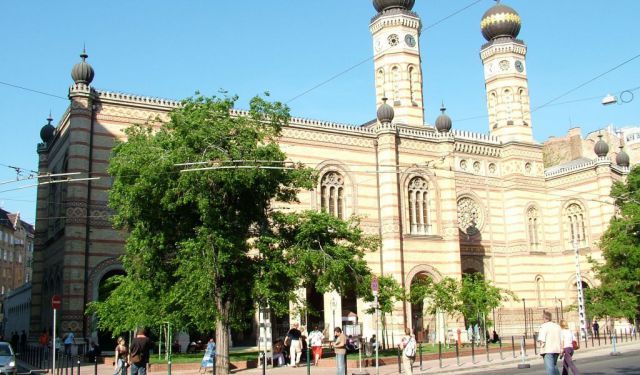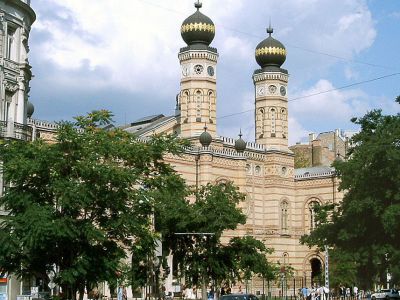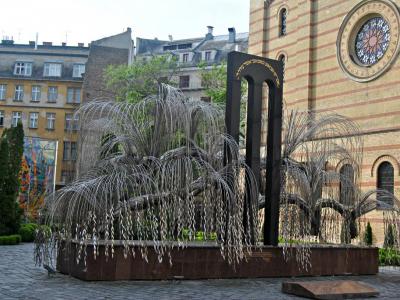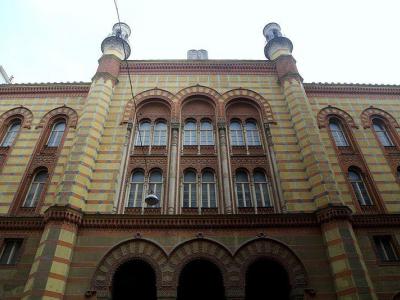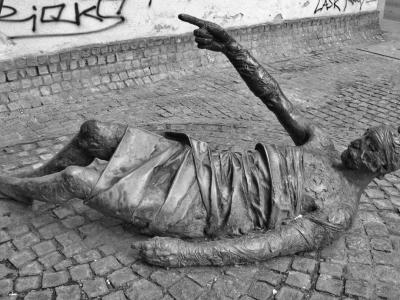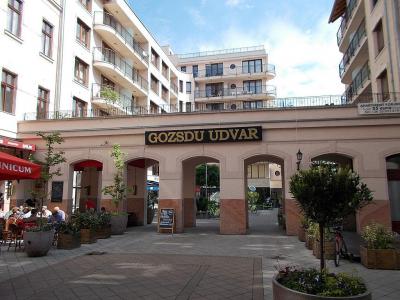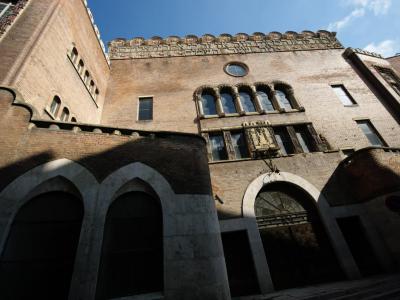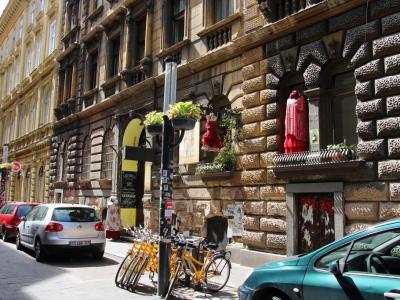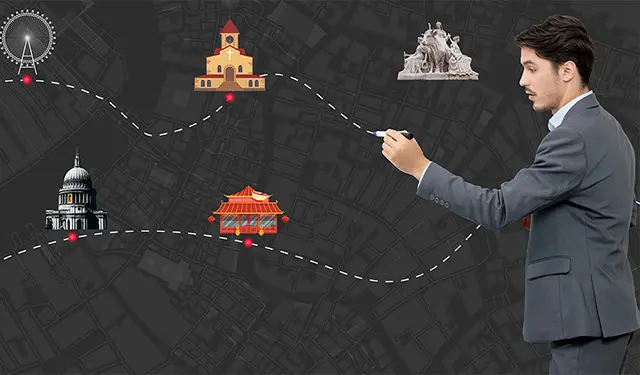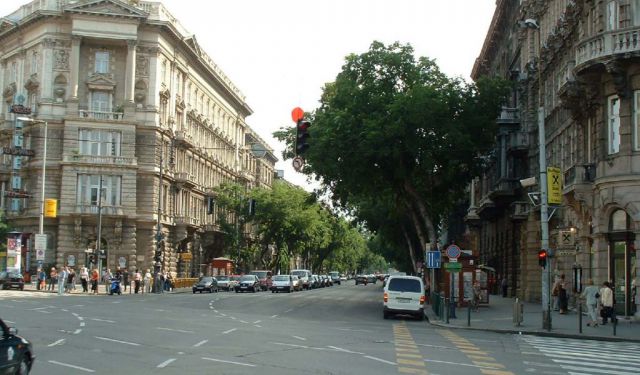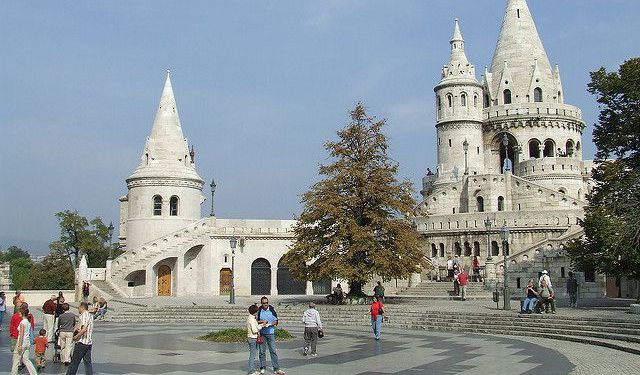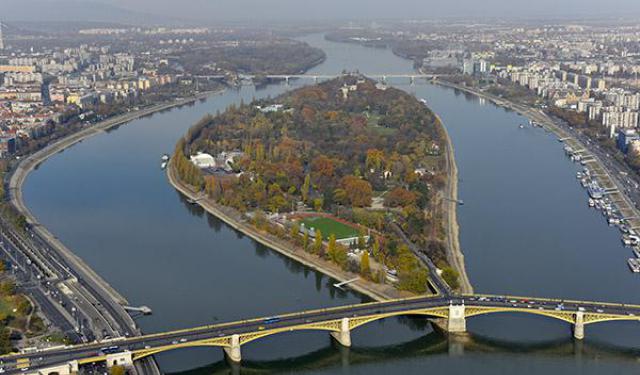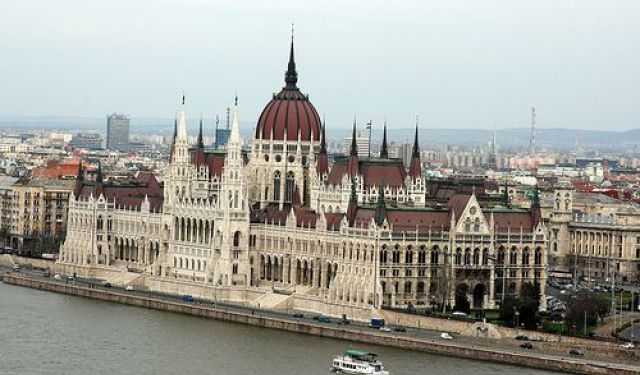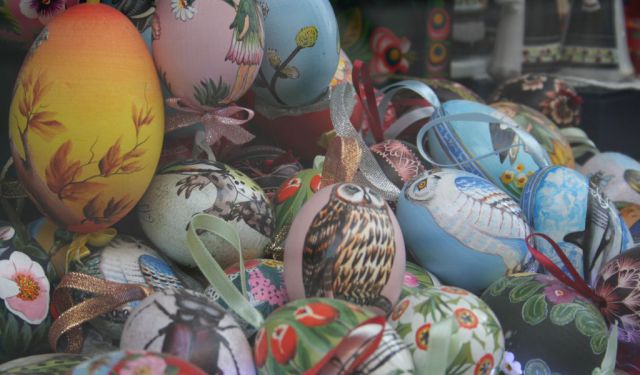Audio Guide: Jewish Quarter Walking Tour (Self Guided), Budapest
Jews were officially allowed to settle in Pest in the early 18th century. By the late 1700s, a small but growing community had taken root, and the 19th century brought rapid urbanization and expansion. The Jewish population soared, with many Jews becoming integral to Budapest’s economic and cultural life.
Following the Nazi occupation in March 1944, they were forced into a ghetto centered in the Jewish Quarter. Tens of thousands were crammed into overcrowded, brutal conditions, where many died from starvation, disease, or were deported to concentration camps. Later, under communism, religious life was suppressed, and the quarter slipped into decline. Institutions closed, synagogues were repurposed, and only a small, persistent community remained, worshiping in near-empty halls.
After the fall of communism in 1989, the Jewish Quarter began a remarkable revival. Synagogues and heritage sites underwent major renovations, and the area now thrives with Jewish festivals, museums, and educational centers. At its heart stands the magnificent Great Synagogue - the largest in Europe and among the largest worldwide. Its bold Moorish Revival design, topped with twin onion-domed towers, has become a defining symbol of the neighborhood and of Budapest itself. Just next door, the Jewish Museum sheds light on centuries of Jewish life in Hungary.
You will also find the touching Tree of Life memorial - a sculpted weeping willow whose metal leaves bear the names of Hungarian Jews lost during the Holocaust. Nearby, tributes to heroes like Raoul Wallenberg and Carl Lutz quietly honor the extraordinary efforts made to save lives during the darkest times.
The quarter has more recently become known for its bars, eateries, and street art. Be sure to wander through the Gozsdu Courtyard, and if you’re looking for the pulse of the nightlife, head over to Kazinczy Street, where the famous “ruin bars,” street food, and eclectic atmosphere create a truly unforgettable experience.
Among all the city’s neighborhoods, the Jewish Quarter often leaves the biggest and most lasting impression, making it well worth exploring in depth. Set off on our walking tour and experience it at your own pace!
Following the Nazi occupation in March 1944, they were forced into a ghetto centered in the Jewish Quarter. Tens of thousands were crammed into overcrowded, brutal conditions, where many died from starvation, disease, or were deported to concentration camps. Later, under communism, religious life was suppressed, and the quarter slipped into decline. Institutions closed, synagogues were repurposed, and only a small, persistent community remained, worshiping in near-empty halls.
After the fall of communism in 1989, the Jewish Quarter began a remarkable revival. Synagogues and heritage sites underwent major renovations, and the area now thrives with Jewish festivals, museums, and educational centers. At its heart stands the magnificent Great Synagogue - the largest in Europe and among the largest worldwide. Its bold Moorish Revival design, topped with twin onion-domed towers, has become a defining symbol of the neighborhood and of Budapest itself. Just next door, the Jewish Museum sheds light on centuries of Jewish life in Hungary.
You will also find the touching Tree of Life memorial - a sculpted weeping willow whose metal leaves bear the names of Hungarian Jews lost during the Holocaust. Nearby, tributes to heroes like Raoul Wallenberg and Carl Lutz quietly honor the extraordinary efforts made to save lives during the darkest times.
The quarter has more recently become known for its bars, eateries, and street art. Be sure to wander through the Gozsdu Courtyard, and if you’re looking for the pulse of the nightlife, head over to Kazinczy Street, where the famous “ruin bars,” street food, and eclectic atmosphere create a truly unforgettable experience.
Among all the city’s neighborhoods, the Jewish Quarter often leaves the biggest and most lasting impression, making it well worth exploring in depth. Set off on our walking tour and experience it at your own pace!
How it works: Download the app "GPSmyCity: Walks in 1K+ Cities" from Apple App Store or Google Play Store to your mobile phone or tablet. The app turns your mobile device into a personal tour guide and its built-in GPS navigation functions guide you from one tour stop to next. The app works offline, so no data plan is needed when traveling abroad.
Jewish Quarter Walking Tour Map
Guide Name: Jewish Quarter Walking Tour
Guide Location: Hungary » Budapest (See other walking tours in Budapest)
Guide Type: Self-guided Walking Tour (Sightseeing)
# of Attractions: 7
Tour Duration: 1 Hour(s)
Travel Distance: 1.2 Km or 0.7 Miles
Author: DanaOffice
Sight(s) Featured in This Guide:
Guide Location: Hungary » Budapest (See other walking tours in Budapest)
Guide Type: Self-guided Walking Tour (Sightseeing)
# of Attractions: 7
Tour Duration: 1 Hour(s)
Travel Distance: 1.2 Km or 0.7 Miles
Author: DanaOffice
Sight(s) Featured in This Guide:
- Great Synagogue (Dohany Street Synagogue)
- Tree of Life / Holocaust Memorial Park
- Rumbach Street Synagogue
- Carl Lutz Memorial
- Gozsdu Courtyard (Gozsdu-udvar)
- Orthodox Synagogue
- Kazinczy Street
1) Great Synagogue (Dohany Street Synagogue) (must see)
Built in the 1850s for the Neolog Jewish community, this synagogue ranks as the second-largest in the world, second only to Temple Emanu-El in New York. Much like the one on nearby Rumbach Street, it was designed by Viennese architect Ludwig Forster, embracing a richly detailed Moorish Revival style. The building forms part of a larger Jewish Quarter complex that includes the Heroes’ Temple, a graveyard, a Holocaust memorial, and the Jewish Museum. During World War II, Dohány Street marked the boundary of the Budapest Ghetto, and even today, the area carries a profound sense of remembrance.
The synagogue suffered heavy damage during the war and endured years of neglect under communist rule. It wasn’t until the 1990s that an extensive restoration finally returned it to its former grandeur. The twin octagonal towers, flanking the main entrance and crowned with onion domes, now make this structure visible all over the city. Inside, the vast nave stretches nearly 40 feet high, revealing Gothic, Romantic, and Byzantine influences. A new mechanical organ fills the space, replacing the original one crafted in the 19th century.
As is traditional, the ground floor seating is reserved for men, while women are seated in the upper galleries. In all, the building can accommodate up to 3,000 worshippers.
Those curious about Jewish history will find much to explore here. Next door is the Jewish Heroes’ Mausoleum, and upstairs, the museum and archives offer informative and thought-provoking exhibits. In the adjacent graveyard, victims of the Holocaust are laid to rest alongside non-Jews who risked their lives to save others. The neighboring park holds a memorial honoring these courageous individuals.
Tip: The synagogue offers guided group tours in several languages. Visitors are asked to observe a modest dress code; if needed, special coverings are provided at the entrance.
The synagogue suffered heavy damage during the war and endured years of neglect under communist rule. It wasn’t until the 1990s that an extensive restoration finally returned it to its former grandeur. The twin octagonal towers, flanking the main entrance and crowned with onion domes, now make this structure visible all over the city. Inside, the vast nave stretches nearly 40 feet high, revealing Gothic, Romantic, and Byzantine influences. A new mechanical organ fills the space, replacing the original one crafted in the 19th century.
As is traditional, the ground floor seating is reserved for men, while women are seated in the upper galleries. In all, the building can accommodate up to 3,000 worshippers.
Those curious about Jewish history will find much to explore here. Next door is the Jewish Heroes’ Mausoleum, and upstairs, the museum and archives offer informative and thought-provoking exhibits. In the adjacent graveyard, victims of the Holocaust are laid to rest alongside non-Jews who risked their lives to save others. The neighboring park holds a memorial honoring these courageous individuals.
Tip: The synagogue offers guided group tours in several languages. Visitors are asked to observe a modest dress code; if needed, special coverings are provided at the entrance.
2) Tree of Life / Holocaust Memorial Park
Tucked just behind Budapest’s Great Synagogue, the Holocaust Memorial Park stands as a tribute to those who risked everything during World War II to protect Hungary’s Jewish population from Nazi persecution. Honored here are those recognized as “Righteous Among the Nations”-individuals who, through courage and compassion, saved lives in the darkest of times.
Among them is Raoul Wallenberg, the Swedish diplomat whose tireless efforts helped thousands and whose mysterious disappearance remains one of history’s enigmas. Also remembered is Ángel Sanz Briz, a Spanish consular officer who quietly issued passports and transformed the Spanish embassy into a safe haven, saving over 5,000 lives in the process.
At the heart of the park stands the Tree of Life, a powerful sculpture shaped like a weeping willow-long a symbol of mourning in Hungarian Jewish tradition. Each of its leaves bears the name of a Holocaust victim buried nearby, a silent forest of remembrance that speaks louder than words.
The park was created during the 1990s, following Hungary’s return to democracy. The Tree of Life itself was completed in 1996, made possible by a donation from Estée Lauder, the famed cosmetics entrepreneur with Hungarian-Jewish roots.
Even from a distance, the tree catches the eye with its shimmering metal leaves. To step closer, you’ll need to pay a modest admission fee, but the experience is one worth taking time for.
Among them is Raoul Wallenberg, the Swedish diplomat whose tireless efforts helped thousands and whose mysterious disappearance remains one of history’s enigmas. Also remembered is Ángel Sanz Briz, a Spanish consular officer who quietly issued passports and transformed the Spanish embassy into a safe haven, saving over 5,000 lives in the process.
At the heart of the park stands the Tree of Life, a powerful sculpture shaped like a weeping willow-long a symbol of mourning in Hungarian Jewish tradition. Each of its leaves bears the name of a Holocaust victim buried nearby, a silent forest of remembrance that speaks louder than words.
The park was created during the 1990s, following Hungary’s return to democracy. The Tree of Life itself was completed in 1996, made possible by a donation from Estée Lauder, the famed cosmetics entrepreneur with Hungarian-Jewish roots.
Even from a distance, the tree catches the eye with its shimmering metal leaves. To step closer, you’ll need to pay a modest admission fee, but the experience is one worth taking time for.
3) Rumbach Street Synagogue
Located in downtown Budapest, within the historic Belváros district, this striking synagogue has been the spiritual home for Hungary’s Neolog Jewish community since the late 1800s. Designed by Otto Wagner-famed for his Art Nouveau landmarks in Vienna-the building draws strong influence from North African and Arabic styles. Its octagonal columns, reminiscent of minarets, and its domed form echo the design of Jerusalem’s Dome of the Rock, though not as a replica-more as a respectful architectural tribute.
The exterior is a feast for the eyes. Ornamental brickwork in rich, earthy tones plays alongside carved stone, stucco details, and beautifully worked iron. A pair of stone tablets representing the Ten Commandments rests above the entrance, while arched windows feature the Star of David in stained glass, framed by Eastern-style curves that add a rhythmic elegance to the façade.
Inside, the space opens into a luminous nave with high ceilings, an ornate dome, vibrant stained glass, and intricate arabesques that flow across the walls. Though the building was severely damaged during World War II and stood dormant for nearly six decades, it has been fully restored thanks to a grant from the Budapest Government. Since the 2021 renovation, the synagogue has embraced a second life-not only as a place of remembrance but as a lively cultural venue. Visitors now come for concerts, theatrical performances, photography exhibitions, and other events that breathe new energy into this historic space.
The exterior is a feast for the eyes. Ornamental brickwork in rich, earthy tones plays alongside carved stone, stucco details, and beautifully worked iron. A pair of stone tablets representing the Ten Commandments rests above the entrance, while arched windows feature the Star of David in stained glass, framed by Eastern-style curves that add a rhythmic elegance to the façade.
Inside, the space opens into a luminous nave with high ceilings, an ornate dome, vibrant stained glass, and intricate arabesques that flow across the walls. Though the building was severely damaged during World War II and stood dormant for nearly six decades, it has been fully restored thanks to a grant from the Budapest Government. Since the 2021 renovation, the synagogue has embraced a second life-not only as a place of remembrance but as a lively cultural venue. Visitors now come for concerts, theatrical performances, photography exhibitions, and other events that breathe new energy into this historic space.
4) Carl Lutz Memorial
As you wander through the old Budapest Ghetto, you might stumble upon a quiet memorial, partly hidden among the trees, dedicated to Swiss diplomat Carl Lutz. Created in 1991 by sculptor Tamás Szabó, the piece shows two bronze figures: an angel above, sending a bolt of cloth down to a figure lying helpless below.
During his time as Swiss Vice-Consul in Budapest, from 1942 to the end of World War II, Carl Lutz saved thousands of Jewish lives. He negotiated a special deal with both the Nazis and the Hungarian government, allowing him to issue safe-conduct passes to British-controlled Palestine. Cleverly stretching the limits of his authority, he treated each pass as covering not just one person, but entire families, issuing tens of thousands of protective letters, each numbered between one and eight thousand. Beyond that, he established around 76 “safe houses” across Budapest, declaring them extensions of the Swiss legation-thus making them off-limits to Nazi and Hungarian forces. One of the best-known of these was the “Glass House” on Vadász Street, where nearly 3,000 Jews found shelter.
In 1965, Yad Vashem, Israel’s official memorial to Holocaust victims, recognized Carl Lutz as one of the "Righteous Among the Nations" for his extraordinary courage and compassion.
During his time as Swiss Vice-Consul in Budapest, from 1942 to the end of World War II, Carl Lutz saved thousands of Jewish lives. He negotiated a special deal with both the Nazis and the Hungarian government, allowing him to issue safe-conduct passes to British-controlled Palestine. Cleverly stretching the limits of his authority, he treated each pass as covering not just one person, but entire families, issuing tens of thousands of protective letters, each numbered between one and eight thousand. Beyond that, he established around 76 “safe houses” across Budapest, declaring them extensions of the Swiss legation-thus making them off-limits to Nazi and Hungarian forces. One of the best-known of these was the “Glass House” on Vadász Street, where nearly 3,000 Jews found shelter.
In 1965, Yad Vashem, Israel’s official memorial to Holocaust victims, recognized Carl Lutz as one of the "Righteous Among the Nations" for his extraordinary courage and compassion.
5) Gozsdu Courtyard (Gozsdu-udvar)
Tucked away in the heart of Budapest’s historic Jewish Quarter, Gozsdu Courtyard is one of the city’s most energetic and eclectic gathering spots. Originally built in the early 1900s, the complex was funded by Emanuil Gojdu, a Romanian-Hungarian lawyer who left his wealth to support local communities. The clever architectural design, with its series of six interconnected courtyards, was both practical and elegant, blending residential living with small shops and artisan workshops.
Today, the courtyard has reinvented itself as a maze of cafés, bars, restaurants, art galleries, and boutique shops. It’s an ideal place for a laid-back brunch, an afternoon stroll through pop-up artisan markets, or diving headfirst into the buzzing nightlife scene. Sipping craft cocktails, catching live music, or simply people-watching from a sunny terrace, you’ll always feel the electric pulse running through the space.
By day, Gozsdu offers a relaxed, family-friendly vibe. Coffee aromas mingle with the sounds of street musicians, and you might stumble upon vintage treasures or quirky art exhibits. But when the sun sets, the atmosphere shifts. Fairy lights flicker overhead, the patios come alive, and a lively soundtrack of laughter, clinking glasses, and music fills the air.
The courtyard’s location also places you right at the heart of the Old Jewish Quarter, just steps from cultural landmarks like the Dohány Street Synagogue, the Jewish Museum, and several important memorials scattered through the neighborhood.
Tip: For a few standout spots, check out DIVINO Wine Bar with its excellent range of Hungarian wines, CAFE VIAN for an impressively varied menu, 2 SPAGHI – one of the best pasta places outside of Italy, and the buzzing SPILER ‘bistropub’ which excels by its unique interior ambiance (plus SPILER SHANGHAI across the street for an Asian twist). Most offer both indoor and outdoor seating-perfect for soaking up the atmosphere any time of day.
Today, the courtyard has reinvented itself as a maze of cafés, bars, restaurants, art galleries, and boutique shops. It’s an ideal place for a laid-back brunch, an afternoon stroll through pop-up artisan markets, or diving headfirst into the buzzing nightlife scene. Sipping craft cocktails, catching live music, or simply people-watching from a sunny terrace, you’ll always feel the electric pulse running through the space.
By day, Gozsdu offers a relaxed, family-friendly vibe. Coffee aromas mingle with the sounds of street musicians, and you might stumble upon vintage treasures or quirky art exhibits. But when the sun sets, the atmosphere shifts. Fairy lights flicker overhead, the patios come alive, and a lively soundtrack of laughter, clinking glasses, and music fills the air.
The courtyard’s location also places you right at the heart of the Old Jewish Quarter, just steps from cultural landmarks like the Dohány Street Synagogue, the Jewish Museum, and several important memorials scattered through the neighborhood.
Tip: For a few standout spots, check out DIVINO Wine Bar with its excellent range of Hungarian wines, CAFE VIAN for an impressively varied menu, 2 SPAGHI – one of the best pasta places outside of Italy, and the buzzing SPILER ‘bistropub’ which excels by its unique interior ambiance (plus SPILER SHANGHAI across the street for an Asian twist). Most offer both indoor and outdoor seating-perfect for soaking up the atmosphere any time of day.
6) Orthodox Synagogue
Nestled in a quiet corner of Budapest’s 8th District, the Orthodox Synagogue is both a physical and spiritual heart of the local Jewish community. Around it, you’ll find a cozy network that includes a kosher restaurant, a school, and a prayer room. Not far away, there’s also a mikvah - a ritual Jewish bath dating back to 1913, and the only one of its kind in the entire city.
The congregation here belongs to a distinctive branch of Hungarian Orthodox Judaism, an offshoot of Conservative Judaism. They’ve preserved many traditions brought over by Jewish immigrants from Germany and Moravia, blended with a deep Hassidic influence that traces its roots to Poland and Galatia.
From the outside, the synagogue’s Art Nouveau façade shows its age. But step inside, and you’re greeted by a beautifully restored interior, alive with bright colors and traditional Hungarian motifs. An unusually designed Bimah - something like an altar - stands at the center, surrounded by original stained glass windows placed high under the roof. There’s a small fee to enter, and from the main door to the right, you can also access the side and rear courtyards. It’s well worth a look: the side walls are lined with historic photos that tell the story of the building, and in the rear courtyard, you’ll come across a striking metal wedding canopy.
The congregation here belongs to a distinctive branch of Hungarian Orthodox Judaism, an offshoot of Conservative Judaism. They’ve preserved many traditions brought over by Jewish immigrants from Germany and Moravia, blended with a deep Hassidic influence that traces its roots to Poland and Galatia.
From the outside, the synagogue’s Art Nouveau façade shows its age. But step inside, and you’re greeted by a beautifully restored interior, alive with bright colors and traditional Hungarian motifs. An unusually designed Bimah - something like an altar - stands at the center, surrounded by original stained glass windows placed high under the roof. There’s a small fee to enter, and from the main door to the right, you can also access the side and rear courtyards. It’s well worth a look: the side walls are lined with historic photos that tell the story of the building, and in the rear courtyard, you’ll come across a striking metal wedding canopy.
7) Kazinczy Street
Right in the heart of Budapest’s Jewish Quarter, Kazinczy Street bursts with a colorful mix of cultural heritage, one-of-a-kind events, a very diverse gastronomy scene, and buzzing nightlife venues. As you walk along, you’ll come across the Orthodox Synagogue, cozy kosher restaurants, and bakeries serving up traditional Jewish dishes and pastries. Many of the buildings, along with various monuments, quietly tell the story of the neighborhood’s past.
If you’re hungry for a taste of tradition, head over to CARMEL, where whitewashed walls frame a large dining space and classic favorites like chicken soup, cholent, and fish dishes are always on the menu. MACESZ BISTRO is another strong choice for a sit-down meal. But if you’re craving something quick and authentically Hungarian, BORS GASTRO BAR has you covered with some of the best street food in town. For even more variety, STREET FOOD KARAVAN offers an incredible lineup of international flavors, all easy on the wallet.
Within easy striking distance, you will also find the street’s famous ruin pubs. Places like SZIMPLA KERT, ELLATO KERT, and KŐLEVES serve up cheap eats and drinks in quirky, retro settings that feel like a cross between an art project and a secret garden. SZIMPLA KERT, one of the pioneers, hosts live music, film nights, and even a farmers’ market every Sunday - a true reflection of the neighborhood’s creative energy.
Art lovers will want to keep an eye out for colorful street murals, while history enthusiasts can visit the nearby Hungarian Electrotechnical Museum. And if you happen to be in town at the start of summer, don’t miss Judafest - a lively celebration of Hungarian Jewish culture, packed with music, food, and tradition.
If you’re hungry for a taste of tradition, head over to CARMEL, where whitewashed walls frame a large dining space and classic favorites like chicken soup, cholent, and fish dishes are always on the menu. MACESZ BISTRO is another strong choice for a sit-down meal. But if you’re craving something quick and authentically Hungarian, BORS GASTRO BAR has you covered with some of the best street food in town. For even more variety, STREET FOOD KARAVAN offers an incredible lineup of international flavors, all easy on the wallet.
Within easy striking distance, you will also find the street’s famous ruin pubs. Places like SZIMPLA KERT, ELLATO KERT, and KŐLEVES serve up cheap eats and drinks in quirky, retro settings that feel like a cross between an art project and a secret garden. SZIMPLA KERT, one of the pioneers, hosts live music, film nights, and even a farmers’ market every Sunday - a true reflection of the neighborhood’s creative energy.
Art lovers will want to keep an eye out for colorful street murals, while history enthusiasts can visit the nearby Hungarian Electrotechnical Museum. And if you happen to be in town at the start of summer, don’t miss Judafest - a lively celebration of Hungarian Jewish culture, packed with music, food, and tradition.
Walking Tours in Budapest, Hungary
Create Your Own Walk in Budapest
Creating your own self-guided walk in Budapest is easy and fun. Choose the city attractions that you want to see and a walk route map will be created just for you. You can even set your hotel as the start point of the walk.
Andrassy Avenue Walking Tour
Dating back to 1870 and recognized as a World Heritage site, Andrássy Avenue is a long, wide boulevard named after Prime Minister Gyula Andrássy (served 1867–71) that connects Budapest's downtown with the City Park. The entire stretch is lined with cafés, restaurants, luxury shops, as well as cultural institutions, elegant neo-Renaissance apartment blocks, mansions, and embassies with... view more
Tour Duration: 2 Hour(s)
Travel Distance: 2.8 Km or 1.7 Miles
Tour Duration: 2 Hour(s)
Travel Distance: 2.8 Km or 1.7 Miles
Buda Introduction Walking Tour
Hungary’s capital is relatively young, having emerged in the late 19th century after the merger of two neighboring towns-Buda on the western bank of the Danube and Pest on the eastern side. Buda, with its hills and historic character, is home to the grand Hapsburg palace, still exuding the imperial charm of a time when wealth and power reigned.
From the heights of Castle Hill or Gellért Hill... view more
Tour Duration: 2 Hour(s)
Travel Distance: 3.8 Km or 2.4 Miles
From the heights of Castle Hill or Gellért Hill... view more
Tour Duration: 2 Hour(s)
Travel Distance: 3.8 Km or 2.4 Miles
Margaret Island Walking Tour
Stretching for around 2.5 km, Margaret Island (“Margit-sziget”) on the river Danube is a popular green oasis / recreational area that serves as Budapest's playground since the 1870s. Flush with beautiful landscaped parks, ancient ruins and various sports facilities, the island can be accessed either by the historical Margaret Bridge on the south or the Arpad Bridge in the north, from... view more
Tour Duration: 1 Hour(s)
Travel Distance: 2.4 Km or 1.5 Miles
Tour Duration: 1 Hour(s)
Travel Distance: 2.4 Km or 1.5 Miles
Pest Introduction Walking Tour
Separated from its western neighbor Buda by the wide sweep of the Danube, the eastern side of Budapest takes up almost two-thirds of the city. While Buda rises in hills and castle-topped cliffs, Pest spreads out across a flat plain, buzzing with energy and a rather bourgeois spirit. Some of Hungary’s most iconic landmarks call this side home, including the grand Parliament building itself. No... view more
Tour Duration: 2 Hour(s)
Travel Distance: 4.3 Km or 2.7 Miles
Tour Duration: 2 Hour(s)
Travel Distance: 4.3 Km or 2.7 Miles
Souvenir Shopping
It will definitely be a pity to leave Budapest without exploring local specialty shops and bringing home something authentically Hungarian. A large number of the city’s specialty shops are found on Váci Street, a pedestrian thoroughfare that parallels the Danube, extending for more than 15 blocks, with something for every taste and wallet. At its most southerly end, you will find Central Market... view more
Tour Duration: 1 Hour(s)
Travel Distance: 1.4 Km or 0.9 Miles
Tour Duration: 1 Hour(s)
Travel Distance: 1.4 Km or 0.9 Miles
Useful Travel Guides for Planning Your Trip
15 Must Buy Hungarian Things in Budapest
Other than the standalone language and catchy Czardas tune, there's a lot more to memorize Hungary by. Here are some of the things you might want to carry from Budapest to your family and friends back...
The Most Popular Cities
/ view all
